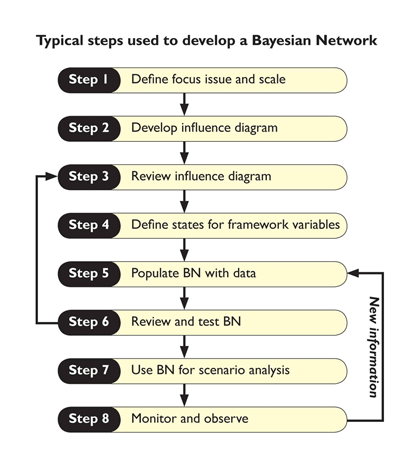Projects
The Knowledge Integration Theme is made up of one project.
Project 6 – Decision Networks
Leader: Prof. Tony Jakeman, Australian National University, Canberra
Objectives
- To develop the capacity of regional NRM bodies to build and use decision networks. So that the decision networks are relevant and useful to the end-users, partner NRM and CMA organisations will be involved in their construction, and will be trained in how to build and alter decision networks.
- To undertake complementary research to incorporate a wide range of behaviours into the decision networks (for example, time series responses, feedback, uncertainty and spatial scales), and reduce unnecessary complexity in the decision networks.
Aims
- To develop decision networks that will assist NRM and CMA organisations in targeting their investment and intervention activities to manage for improved resource target outcomes. The decision networks will:
- Capture knowledge and assumptions in links between current NRM intervention and resource condition;
- Evaluate the effectiveness of past NRM interventions on resource condition;
- Assist regional NRM organisations with their planning activities; 5.Inform future public and private investments for improving effective environmental management.

Approach
Phase 1 (July 2006-October 2007)
- Train partner NRM and CMA staff in developing and using Bayesian Decision Networks (BDNs). (Powerpoint presentation from a June 2007 BDN training workshop)
- Develop simple BDNs in collaboration with NRM and CMA groups to meet their short-term needs.
- Develop the structure of Knowledge Integration BDN frameworks.
Phase 2 (October 2007 – April 2010)
- Populate the integrated frameworks from Phase 1.
- Further develop the frameworks based on priority issues identified across NRM and CMA partner organisations (native vegetation condition and water), and incorporate important new knowledge and data from the Knowledge Discovery and student projects. Evaluate the frameworks.
- Document the process of developing and populating the integration frameworks.
Outputs (what and when)
- Multi-objective planning tools, based on decision networks, developed (March 2010).
- Partner regional NRM staff trained in the use and development of multi-objective planning tools through the delivery of workshops and follow-up assistance (commencing in March 2007 and finishing in March 2010).
- National and regional training workshops for non-partner regional NRM organisations delivered (April 2010).
- Workshop manuals, training materials and user-friendly decision network software developed for regional NRM bodies (April 2010).
Outcomes
Addresses Landscape Logic Outcome 3, social learning about the interdependencies between management decisions through the development and use of multi-objective planning tools that capture qualitative and quantitative information, and Outcome 4, regional staff in each partner region experienced in the use of multi-objective planning tools.
- Decision networks for investment in native vegetation condition and managing impacts of land use and land management on water quality and quantity developed
- Build capacity within regional organisations to construct and use decision networks.
External collaborations and links
The key output of the Knowledge Integration project is a framework that integrates new knowledge generated by the Knowledge Discovery projects with the outputs of existing models, decision support systems and the experience of catchment managers and landholders. The framework(s) and associated decision support tools will provide an important product for the Knowledge Broking project (Project 7).
Scoping Process (how did we get there?)
The Knowledge Integration team has identified the needs of partner NRM and CMA organisations via a series of Regional workshops (November 2006 – February 2007). These activities have assisted in defining the needs of the regional partners, and helped to identify priorities for NRM within each organisation. These priorities were used to focus activities of the Knowledge Integration project, and in response to the regional workshops, the activities of the Knowledge Integration team have been divided into two phases as described in the Approach.
Click here to see the Decision Networks poster (pdf, July 2007), Integrating economic values into catchment modelling poster (Marit Kragt, PhD student) and Modelling of river health using Bayesian Networks poster (Serena Chen, PhD student).



